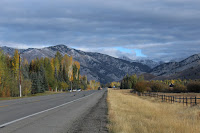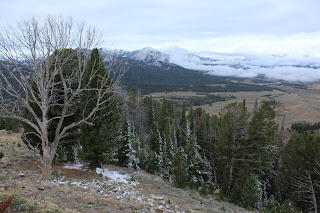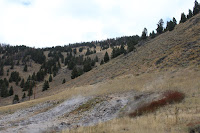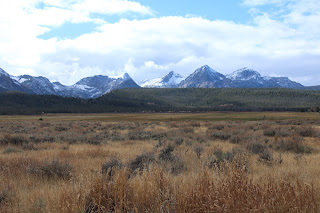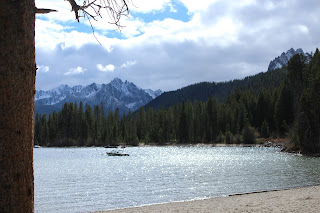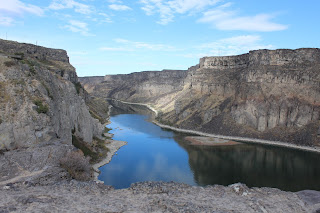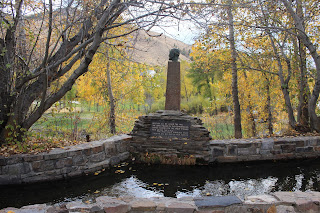RETIREMENT TRIP #7
Fire and Water: The End of the Trail
When we left the motel this morning, the mountain peaks were
clear, except for a small layer of clouds behind them.
 |
| The morning sun casts shadows on the mountains as the old wagons of Stanley, Idaho, sit at rest. |
According to the motel clerk, “if you can see
a peak here, we call it ‘clear’.”
 |
| From the Dead End street in Stanley, we watch the sun come up to light the mountains. |
 |
| With pines in the darkened shadows of early morning, the peaks around Stanley stand out in the sun. |
 |
| Farther down the road from Stanley, views are magnificent. |
“I’m putting on my fleece jacket next stop,” I told
him. The sweater alone wasn’t cutting
it! Worst off were my fingers!
 |
| Unaware of the scenery, cows graze peacefully near the main road. |
Andy sat in the car with the motor running, but he checked
the shots each time.
 |
| Peaks near Stanley are snow-coated by early October. Winter has come here. |
With each stop
the clouds had increased, and there was less and less sun on the peaks.
 |
| Outside of Stanley, peaks rise in silence in the cold October air. |
 |
| The sun still highlights the peaks as we head away from Stanley. |
Andy read the signs, as I snapped away, trying to capture reflections on
the water before we lost the sun completely.
 |
| Clouds hug the shore of Stanley Lake at the base of McGown Peak, already draped in snow. |
McGown Peak, 9.860 feet and already snow-covered on October
7, was named for the McGown brothers who were cattle ranchers in the area. They drove their herds past the mountain.
 |
| From the campground, McGown Peak, with glaciers showing, towers high over the landscape. |
 |
| In the cold morning air, a cloud hangs low at McGown Peak. |
 |
| Stanley Lake reflects McGown Peak in the early morning sun. |
We walked around the lookout along the lake, noticing a
couple anglers in boats on the water in the early morning, hearing a young boy
call to his father at a camp site, feeling the frost on the railing.
Clouds had blanketed almost the whole sky. The sun on the peaks was gone. We had lost the reflection of the mountains on
the water. It was time to move on.
An hour later and a few thousand feet lower in elevation,
the sun peaked through again.
We were coming out of the mountains. “They make their own weather,” said
Andy. Cold weather, that is. The prediction for Boise was 74.
Kirkham Hot Springs at Boise National Forest Campground
entertained a number of camping trailers.
But there were no signs of life.
Families were all dabbling and wading and soaking in the Hot Springs. Steam rose in waves and water streamed from
the gravel banks into greenish pools before tumbling to the South Fork of the
Payette River.
 |
| Steam rises from the bankside of the Payette River. |
“No dogs, no dishes, no nudity” read the campground
signs. That was in reference to Hot
Springs bathing.
Adjoining hills and the mountainsides for some miles before
the Hot Springs showed severe fire damage.
We looked at the signs; the fire occurred in 1989. Even though there is some low growth, the
area has not recovered. It’s a sad sight
to see burned out hills and avalanche-prone slopes in this ruggedly beautiful
country. That fire got so hot it
actually created a funnel cloud in the narrow valley.
On the way back up the slope out of the Boise National
Forest, we drove past a new burn. “This
just occurred this year, I’d guess,” said Andy, “and it was an unusually low
fire year.”
 |
| The Pioneer Fire destroys thousands of acres of forest in 2016. |
We could still smell the char with the windows closed, and
the devastation extended for miles. We
read later that it was the Pioneer Fire of 2016. It had burned more than 1,300 acres at first
report. More than 300 firefighters battled the blaze that started on July 21st. Hot and dry conditions contributed to the
spread.
 |
| The front of the old Wells Fargo office reflects the atmosphere of the old mining town of Idaho City. |
The fire continued to burn. And this year as of September 12, it had consumed 185,895
acres in two months and was only 56% contained.
Cooler temperatures and northwest winds were expected to slow the advance
and aid containment efforts.
“I heard the federal government has been spending 1.8
billion dollars a year to fight fires in the West,” said Andy, “and that’s not
what state governments contribute.”
 |
| In Idaho City, Sue poses with a local outside the local saloon. |
Most of the burned trees here weren’t ready to be harvested
by lumber companies. So most of the burn is
total loss.
Mores Creek Summit, at 6,118 feet, was the dividing
line. The Boise side wasn’t burned at
all. No charcoal, no smell and suddenly
patches of blue sky. Some of the curves
and bends were 25 m.p.h. speed limit with elevation changes of 4,000 feet twice. And Route #21 is the main highway. No wonder
the advertising said Stanley was remote and removed!
We stopped at the Sarsaparilla Ice
Cream store in Idaho City, population 458, for coffee. “This was an old mining town,” said
Andy. Diamond Lil’s Restaurant and
Saloon was closed, for sale by owner, appointment only. But the City Courthouse and the Hall of
Records are still in use. Planning and Zoning is in a log cabin next door. The town bought the Court House building for
$1,000 in 1903. Many of the other
buildings on Main Street date back to the 1860’s.
 |
| Little is left after the dry season in Lucky Peak Reservoir. |
The town was founded in 1862, and
originally called Bannock. At its peak
in the mid-1860’s, there were more than 200 businesses in town, including three
dozen saloons and two dozen law offices.
Its 1864 population of 7,000 made it the largest city in the
Northwest. Most departed the mountains
once mining declined. By 1920, there
were only 120 permanent residents.
Lucky Peak Reservoir was empty, but
we could see where the water comes when it fills in the spring. “It’s a reservoir,” said Andy. “It could be used for agricultural
purposes.”
 |
| Just a dribble of water is left flowing into the lake at Lucky Peak Reservoir. |
We weren’t far out of Boise, but
this certainly wasn’t the city water supply.
It was totally empty.
We turned into Corps of Engineers
Lucky Peak Lake. It was just immense—and
empty.
“Maybe Idaho doesn’t have as much
water as it seemed,” said Andy, “or the runoff from the mountains is beyond
belief.” The water level was way lower
than the lowest extension on the floating boat ramps. We followed the road downhill for six miles
toward what we thought was the dam. The
road turned to gravel, and water in the stream way below us was going the other
way. This wasn’t the dam.
 |
| A beautiful facility for boating and picnicking, Lucky Peak Reservoir offers summer fun for visitors and residents. |
In places black lava rock had
eroded from the graded sides and tumbled down the embankment. We headed back up toward the entrance.
“The dam must be up the other way,”
said Andy. “But it’s amazing. I’ve never seen any reservoir that low. It must be beautiful when it’s full.”
Arrowrock Dam over Mores Creek
created Lucky Lake. The land on the
opposite side of the bridge wasn’t so lucky.
Multiple hills, 3,782 feet and below, were totally blackened. Here all the sage, grass and cottonwood trees
were solid charcoal. Only patches of
green around four or five houses and a liquor store—all blocks apart—remained
alive. The houses had been saved, but
what they had to look at was devastated.
 |
| Cormorants rest in the outflow river near Arrowrock Dam by the Sandy Point powerhouse. |
Boats were still being launched
from Turner Gulch. We watched a couple
of crafts being hauled in and out of the water. Two little
girls greeted a family of mallards at the water’s edge. A youngish man put his aluminum boat into
the water, got his black lab, and set off across the lake with dog and gun. I wondered what he was allowed to shoot from
the water.
Steadily we climbed on foot back up to the
car. We didn’t have four-wheel drive, and
all the vehicles at the boat launch were four-wheel drive. The cars were all blocked
from rolling backwards with rocks behind the back tires. It was a long climb back up but an
interesting lesson in boat management.
At Sandy Point the powerhouse was
closed, but a beautiful walkway along the outflow led to a state park and
extended swimming beach. Cormorants and
Canada geese lined the waterfront and sunned themselves on rocks by the little
island. We walked the waterfront path. It was
lined with rabbitbrush and wild rose.
“That’s Russian Olive,” said Andy, pointing to the invasive.
“That’s Russian Olive,” said Andy, pointing to the invasive.
“Why would they plant an invasive?”
I asked.
“It’s good for birds,” he
said. “It probably doesn’t require too
much water, and it’s low growing.
And that was it. Our next stop was Boise, the end of the line
for this trip.
Tomorrow, we’d be home.
